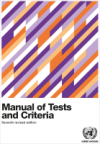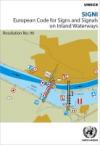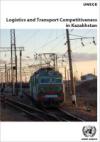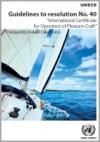Publications
Displaying Results 41 - 60 of 202
- English
The UNRSF 2019 Annual Report is now available. Established two years ago as an innovative United Nations pooled fund, the Annual Report showcases the first concrete results of the UNRSF and thus demonstrates its potential to meet its ambition to substantially reduce death and injuries from road crashes in low and middle-income countries where 93% of the world fatalities occur.
- English
Organizations around the world are quickly adapting their programme and project activities to respond to the COVID-19 pandemic and its consequences. The UN Road Safety Fund is committed to the principles of adaptive programming, partnerships, and relevance. The operationalization of these principles is even more critical during this unparalleled time. This flyer provides tools and tips for
- English
The April 2020 marks the second anniversary of the launch of the United Nations Road Safety Fund (UNRSF). The Fund is now financing 15 projects in 20 low- and middle-income countries to substantially reduce death and injuries from road crashes and to reduce economic losses resulting from these crashes.
- English
As part of the ongoing work on THE PEP a Study on good practices in Mobility Management has been published.Drawing on concrete experiences from across the Pan-European region, the guide, developed under the Transport Health and Environment Pan-European Programme (THE PEP), provides practical policy considerations enriched by a total of 22 good practices from 17 countries that set out the
- English
The UNECE “White Paper on the progress, accomplishment and future of sustainable inland water transport” is the third edition of a policy paper on the current situation, trends and challenges in inland water transport on European inland waterways of international importance in the region of the Economic Commission for Europe.This third edition follows from the International Conference on
- Pусский
Белая книга ЕЭК ООН о прогрессе, достижении и будущем устойчивого внутреннего водного транспорта является третьим изданием программного документа о текущем положении, тенденциях и проблемах в области внутреннего водного транспорта на европейских внутренних водных путях, имеющих международное значение в регионе Европейской экономической комиссии.Это третье издание следует из материалов
- English
A study on the transport infrastructure and services available in Kyrgyzstan. This document reviews the country’s extensive recent and future transport investments, and sets out recommendations to ensure its transport network is ready to harness the growth in inland transport from rising Asia-Europe trade, particularly in the context of the Belt and Road Initiative.
- English
ST/SG/AC.10/11/Rev.7
Sales No. E.20.VIII.1
ISBN 978-92-1-130394-0
eISBN 978-92-1-004503-2
Languages: E, F, (A, C, R, S forthcoming)
How to order this publication?
This publication is also available online for free (download).
The "Manual of Tests and Criteria" contains criteria, test methods and
- English
These recommendations have been developed in the light of technical progress, the advent of new substances and materials, the exigencies of modern transport systems and, above all, the requirement to ensure the safety of people, property and the environment. They are addressed to governments and international organisations concerned with the regulation of the transport of dangerous goods. The
- English
The GHS addresses classification of chemicals by types of hazard and proposes harmonized hazard communication elements, including labels and safety data sheets. It aims at ensuring that information on physical hazards and toxicity from chemicals be available in order to enhance the protection of human health and the environment during the handling, transport and use of these chemicals.
The GHS
- English
The European Code for Signs and Signals on Inland Waterways (SIGNI), adopted by resolution No. 90 of the Working Party on Inland Water Transport on 5 October 2018, provides recommendations for the competent authorities for the installation and application of buoyage and marking on European inland waterways contained in the fifth revision of CEVNI (ECE/TRANS/SC
- English
Improving the competitiveness of Kazakhstan as a transport logistics centre at the crossroads of Europe and Asia could enable the country to unlock significant untapped benefits of growing cargo flows between the two continents. This study identifies the transport infrastructure and services available in Kazakhstan, reviews the country’s extensive recent and future transport investments,
- English
The European Agreement concerning the International Carriage of Dangerous Goods by Inland Waterways (ADN) done at Geneva on 26 May 2000 under the auspices of the United Nations Economic Commission for Europe (UNECE) and the Central Commission for Navigation on the Rhine (CCNR) has been in force since February 2008. The Agreement currently has eighteen Contracting Parties. The Regulations
- English
The International Certificate for Operators of Pleasure Craft (ICC) which is issued in accordance with resolution No. 40, is recognized by more than 25 United Nations Member States in the ECE region and beyond. The Guidelines to resolution No. 40 are based on the frequently asked questions of administrations and recreational boaters in order to facilitate an
- English
UNECE provides a common basis for harmonized traffic regulations on European waterways through the European Code for Inland Waterways (CEVNI), which contains the core uniform rules applicable to traffic on inland waterways. The fifth revised edition of CEVNI (CEVNI 5, available as PDF and
- English
Adopted on 30 September 1957 in Geneva under the auspices of the United Nations Economic Commission for Europe (UNECE), the ADR entered into force on 29 January 1968. This authoritative Agreement is intended to increase the safety of international transport of dangerous goods by road. Its Annexes A and B contain the technical requirements for road transport, i.e. the conditions under
- English
The present publication (download here) concerns intermodal transport, with a particular focus on the role of railways in intermodality and the importance of transport documents computerisation for intermodal transport. The publication is divided in three main parts: a first section discusses the intermodality and the role of
- English
The GHS addresses classification of chemicals by types of hazard and proposes harmonized hazard communication elements, including labels and safety data sheets. It aims at ensuring that information on physical hazards and toxicity from chemicals be available in order to enhance the protection of human health and the environment during the handling, transport and use of these chemicals.The GHS
- English
These recommendations have been developed in the light of technical progress, the advent of new substances and materials, the exigencies of modern transport systems and, above all, the requirement to ensure the safety of people, property and the environment. They are addressed to governments and international organisations concerned with the regulation of the transport of dangerous goods. The


















